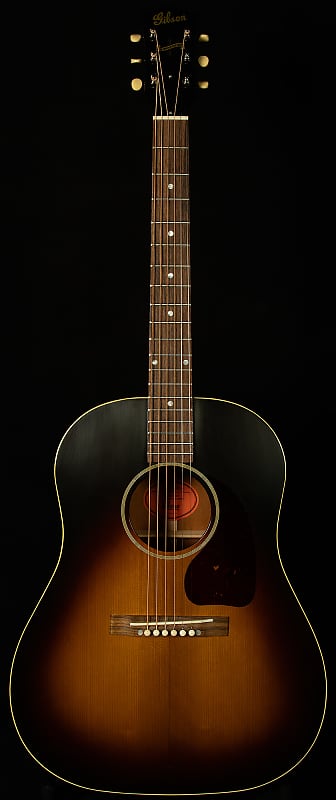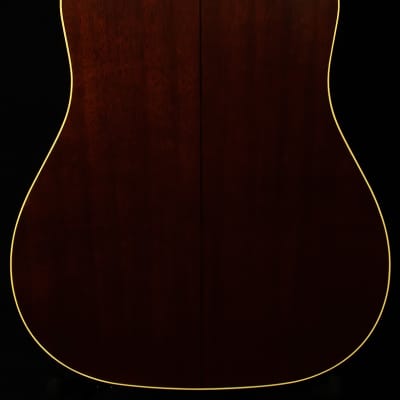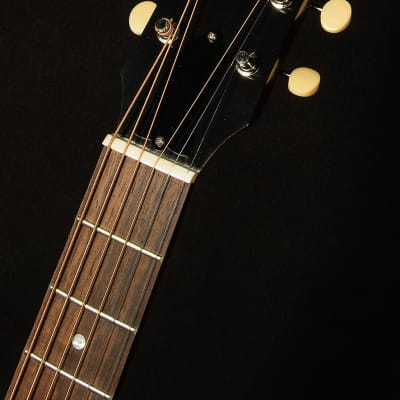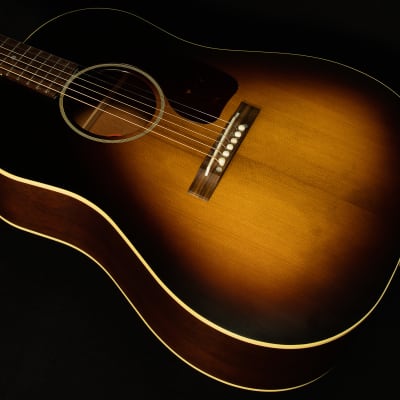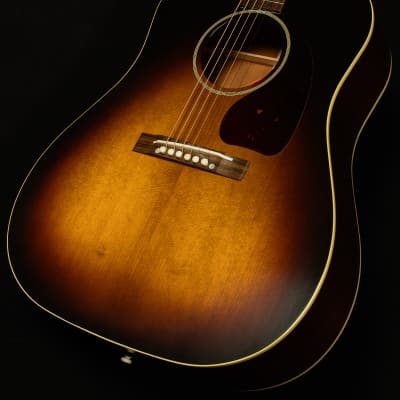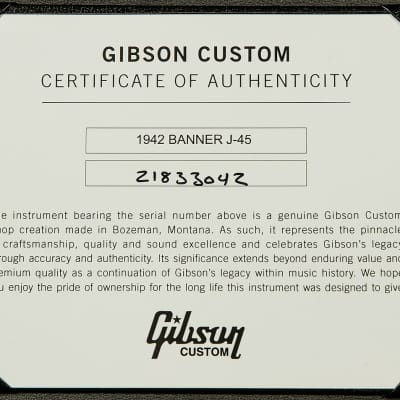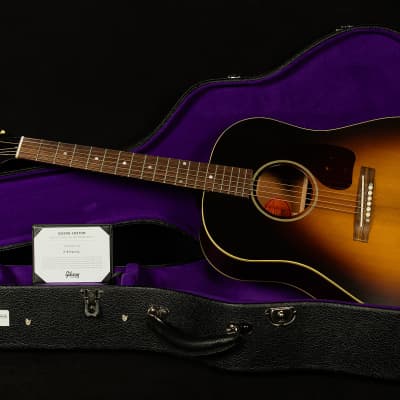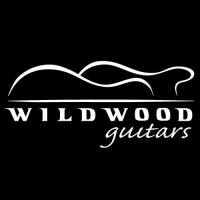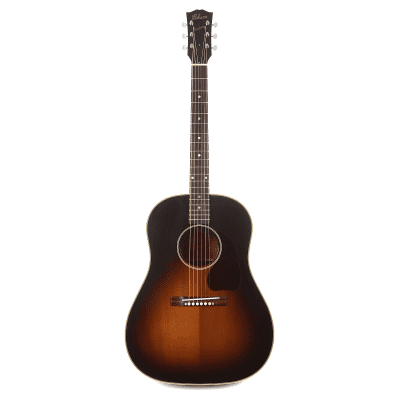The Beauty of the Banner
The Gibson Acoustic Custom Shop 1942 Banner J-45 you see to the right has one of the most fascinating stories in all of six-string history. Everyone knows that Gibson's "banner guitars" (World War II-era guitars named for the banner logo on their headstocks) are among the most revered vintage guitars of all time, but there's more to the story here than wood and wire. The tale of the Banner J-45 has it all: war, mystery, intrigue, unlikely heroes, and redemption. These modern recreations are stunning tributes to the Banner J-45's legacy, and they exemplify the high standards of quality and peerless craftsmanship of our friends at Gibson Montana. But, before we jump into all the reasons these guitars sound so incredible, we have to take a detour to Kalamazoo, Michigan during World War II to understand their magic.
The Story of the Kalamazoo Gals
During World War II, the Gibson Guitar Corporation was in a bit of a pickle. Almost all of its employees were overseas fighting in the war, and production ground to a halt as a result. To complicate matters more, Gibson
technically wasn't supposed to divert workers and material from the war effort to build guitars.
But, the world needs music, and you need guitars to make music (well, most music, anyway), so Gibson opted to keep the factory open. But, they still needed workers, and more and more men were getting drafted every day. So, as many other companies did during World War II, they turned to women in their hour of need, and soon the Gibson factory on Patterson Street was bustling with gals from Kalamazoo.
It is far beyond the purview of this product overview text to tell the entire story of all these skilled women (and if you want more information, John Thomas wrote a fascinating book about them called "Kalamazoo Gals: A Story of Extraordinary Women and Gibson’s Banner Guitars of World War II"). But, here's the condensed version: the women that worked at Gibson from 1941 to 1945 churned out some of the finest acoustic guitars in the world. Many of them weren't musicians, and they viewed their work at Gibson as just a job. Nevertheless, they produced holy grail guitar after holy grail guitar in relative anonymity over the course of the war.
Phantom Guitars
Unfortunately, they never received any credit for their work until recently. According to their records, Gibson didn't produce any guitars during World War II, and any that they sold were labeled "New Old Stock" produced before the war. Officially, the Kalamazoo Gals' work didn't exist. They kept their wartime activities clandestine for two reasons: first, because they weren't
technically supposed to be building guitars during wartime; and second, because they were afraid musicians wouldn't buy guitars built by women.
The opposite turned out to be true. As time passed, musicians began to realize that Gibsons with the banner logo on the headstock were on another level of greatness. Resale prices steadily climbed, and soon the guitars built by the Kalamazoo Gals became some of the most sought-after guitars on the vintage market.
The Kalamazoo Gals finally got their moment in the spotlight, too. After John Thomas published his book, they received the recognition they deserved for their contributions to Gibson's legacy and Kalamazoo history.
A Tribute For the Ages
Of course, since John Thomas's book brought them back into the spotlight, the price of Banner Gibsons has been on a steady rise. Thankfully, our friends at Gibson have built these wonderful recreations at the Custom Shop in their Bozeman plant. Using old-world manufacturing techniques and top-notch tonewoods, the master luthiers of Montana have captured the magic and mojo of the banner-era Gibsons in a modern package.
The top wood is the cornerstone of any acoustic guitar, and Gibson chose to use premium red Adirondack spruce for the 1942 Banner J-45, a move that we wholeheartedly applaud. Here at Wildwood, we love Adirondack spruce's tonal properties the way Kirk Hammett loves wah pedals: truly and deeply, with our entire collective heart. It just gives acoustic guitars a little more of everything: more percussive articulation in the attack, more projecting power, more volume, and more headroom. When paired with mahogany back and sides in these J-45s, it produces a warm, open, full tonality with plenty of midrange punch, and it responds equally well to subtle, nuanced fingerstyle playing and enthusiastic bluegrass strumming.
Adirondack spruce is enticing in an unaltered state, but our friends at Gibson took it a step further by putting it through their thermal engineering process. Basically, they torrify the top by subjecting it to heat in a vacuum, which removes all the moisture from the wood and helps it achieve a cellular structure similar to that of a real old guitar. It imparts a clear, woody character to the guitar's sound, and it also helps the guitar sound open, lively, and three-dimensional.
Only a Gibson is Good Enough
We're proud to showcase the 1942 Banner J-45, a guitar with a spectacular sound that tells an incredible story. It's a beautiful tribute to the Kalamazoo Gals and Gibson's rich history, and we are proud to showcase it for our exceptional customers. We know that its spectacular vintage-inspired tone will inspire you to embark on all kinds of exciting fretboard adventures!
- Model: Custom Shop 1942 Banner J-45
- Type: Slope-Shoulder Dreadnought
- Finish Color: Vintage Sunburst
- Finish Type: Thin VOS Nitrocellulose Lacquer
- Top Wood: Thermally-Aged Adirondack Red Spruce
- Bracing: Hand-Scalloped Adirdondack Spruce X Bracing
- Back & Sides Wood: Mahogany
- Neck Wood: Mahogany
- Neck Joint: Compound Dovetail
- Neck Shape: V Profile
- Neck Dimensions: .920 1st - .990 9th
- Fretboard Material: Indian Rosewood
- Fingerboard Inlays: Mother-of-Pearl Dots
- Scale Length: 24 3/4"
- Frets: 19 Legend Wire
- Width at Nut: 1.724"
- Nut Material: Bone
- Binding: Multi-Ply Top, Multi-Ply Back
- Tuners: Period-Correct Open-Back 3-On-A-Side With Cream Buttons
- Bridge: Rosewood Open-Slot Rectangle
- Saddle: Bone
- Pickguard: Tortoise Teardrop
- Case: Hardshell Case
